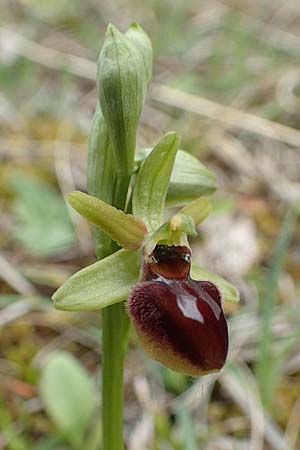![[click] Ophrys araneola, F Dept. Drome 30.4.2004 [click] Ophrys araneola, F Dept. Drome 30.4.2004](fr/araX7726.jpg)

![[click] Ophrys sphegodes, F Grenoble 4.5.2004 [click] Ophrys sphegodes, F Grenoble 4.5.2004](fr/sphX8716.jpg)
F Dept. Drome 30.4.2004
= Ophrys x jeanpertii E.G.CAMUS
D Bad Ditzenbach 3.5.2019
F Grenoble 4.5.2004
| Autoren / Authors: | |||
| Heinrich Gottlieb Ludwig Reichenbach (1793 - 1879), deutscher Botaniker / German botanist | |||
| Carl von Linné (Linnaeus, 1707 - 1777), schwedischer Naturforscher, der das binäre Benennungs-System für Pflanzen + Tiere einführte / Swedish naturalist who introduced the binary naming system for plants + animals | |||
| Etymologie / Etymology: | |||
| Ophrys: | griechischer Pflanzenname, von ophrys = Augenbraue / Greek plant name, from ophrys = eyebrow | ||
| araneola: | kleine Spinne / small spider | ||
| Autoren / Authors: | |||
| Edmond Gustave Camus (1852 - 1915), französischer Botaniker mit Schwerpunkt Orchideen / French botanist with main focus on orchids | |||
| Carl von Linné (Linnaeus, 1707 - 1777), schwedischer Naturforscher, der das binäre Benennungs-System für Pflanzen + Tiere einführte / Swedish naturalist who introduced the binary naming system for plants + animals | |||
| Etymologie / Etymology: | |||
| Ophrys: | griechischer Pflanzenname, von ophrys = Augenbraue / Greek plant name, from ophrys = eyebrow | ||
| jeanpertii: | Henri-Édouard Jeanpert (1861 - 1921), französischer Botaniker / French botanist | ||
| Autoren / Authors: | |||
| Philip Miller (1691 - 1771), englischer Gärtner / English gardener | |||
| Carl von Linné (Linnaeus, 1707 - 1777), schwedischer Naturforscher, der das binäre Benennungs-System für Pflanzen + Tiere einführte / Swedish naturalist who introduced the binary naming system for plants + animals | |||
| Etymologie / Etymology: | |||
| Ophrys: | griechischer Pflanzenname, von ophrys = Augenbraue / Greek plant name, from ophrys = eyebrow | ||
| sphegodes: | wespenähnlich / wasp-like | ||
Volker HOFFMANN vom AHO Baden-Württemberg, der einen Artikel über die Ophrys-Hybriden Baden-Württembergs und seiner Nachbargebiete schreibt, der voraussichtlich im
Jour.Eur.Orch. erscheinen wird, hält diese Pflanze für die Dreifach-Hybride
(Ophrys araneola x Ophrys insectifera) x Ophrys sphegodes.
Als Gründe für die vermutete Beteiligung auch von Ophrys insectifera führt er die silber-blau-graue Farbe des Mals an, dass das Mal leicht hoch gestellt ist,
ein Rest von rot auf den Petalen und die etwas verlängerte Form der Lippe.
Volker HOFFMANN, member of AHO Baden-Württemberg, who is writing an article on the Ophrys Hybrids of Baden-Württemberg and adjacent regions, which will probably be issued in the
Jour.Eur.Orch., believes that this photo shows the triple bastard
(Ophrys araneola x Ophrys insectifera) x Ophrys sphegodes.
As reasons that Ophrys insectifera is involved, too, he mentions the silvery blue-grey color of the speculum, the slightly high position of the speculum on the lip,
a little red tint on the two petals, and the somewhat elongated form of the lip.